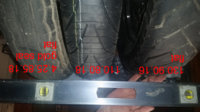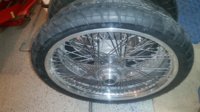An interesting if slightly dated article on tires. It really does cover a lot of the common tire, rim conundrums.
https://www.motointernational.com/blog/news-and-events/post/sharing-daves-ol-tech-articles-episode-3
I'll throw in that if taken to extremes fat rear tires definitely have a negative effect on handling. 300? stupid wide. Guy was riding with some buds and he was really sweating getting that thing around corners. There may have been lots of factors but it sure looked like the front rear alignment in the transition to the lean changed so much that handling was atrocious But I feel the greatest sin commonly committed is levering wider tires on stock rims.
The 86-89 Yamaha Radian 600 runs 16"s front and rear its' possible they would swap on to an XS....
Tire size (front) 110/90-16-59H
Tire size (rear) 130/90-16 67H
It would be interesting to lever some low profile scooter rubber on those rims bolted to an XS, get you the slammed look and maybe handle pretty well, 'til bits start dragging anyways. Would probably work for the inseam challenged.
YAMAHA YX 600 (86-91) (Radian)
Front Rim Size: 2.50x16
Rear Rim Size: 3.00x16
Recommended Front Tire: K591 , size 100/90-16, 30 PSI
Recommended Rear Tire: K591 , size 130/90-16, 32 PSI
OE Replacement Front Tire: K355F, size 110/90H16, 30 PSI
OE Replacement Rear Tire: K355 , size 130/90H16, 32 PSI
Recommended Front Tire: ME330 , size 100/90-16
Recommended Rear Tire: ME550 , size 130/90-16
This example just reinforces what I've been saying. Here is Yamaha selling a bike about the same size/weight and similar size engine as an XS650. Do they choose a narrow tire for the rear to get that superior handling that some of you suggest. No, their engineers chose to use the same size rear tire that my XS650 Special uses. Its obvious they prefer that width of tire on the back.
Note also that they use a 16" tire, not an 18" tire as used on the XS650 Standard.
I think Yamaha engineers knew a thing or two about wheels and tires, and its shows by the size of rear tire they chose.




 This the information highway in action.
This the information highway in action.


